How to Format an Essay
Publication Date: 09 May 2022
Formatting a college essay according to a particular referencing style may sound like an additional burden and someone’s silly caprice. Everybody knows that the most important component of any essay is the content, right? That is how most students think, and they are mostly right, though not entirely.
The point is that formatting is meant to bring order to the otherwise messy reality and essentially simplify things. It may only sound like an additional burden at first, though once you get used to using a particular formatting style, you will find it simple and effective. It will maximize the persuading power of your essay, and make it easier for your readers (including your professor) to grasp your ideas and grade your work.

Our experts from the academic support service have made the following comprehensive guide to help you learn how to format your essay quickly and effectively.
An Overview of the Most Popular Essay Formatting Styles
The most popular college essay formats are MLA, APA, and Chicago.
The MLA abbreviation stands for the Modern Language Association. As the name implies, it is a relatively new and modern formatting style. Here are the fundamental principles of MLA format:
- Page numbers must appear on every page and be one-half inch from the top right margin
- The title page of an academic paper in the MLA style must consist of an author’s name, instructor/professor’s name, name of the course, and paper submission date
- References used in the essay body, as well as the bibliography page in the end, must be formatted according to the MLA citation style
- To cite someone in the body of your essay, you must include the information about the author and year of publication in the parentheses
Another very popular essay formatting style in the academic environment is the APA style. The abbreviation stands for American Psychological Association. It was designed with the purpose to simplify the MLA style and is frequently used to format writing works in humanities and social sciences. It contains the following basic principles:
- An essay in APA format must include the following structural elements: title page, abstract, the main body, and references
- One-inch page margins are applied on all sides
- Each new paragraph must start with a one-half inch interval from the left paragraph margin
- The Times New Roman font style and 12 font size are usually applied
- One must use double-spaced intervals between paragraphs
- One must use a running header on each page
The last most popular essay format is the Chicago style. It originated from an academic environment in Chicago in the early 20th century. There also exists a slightly simplified and streamlined version of this style, called Turabian, named after the founder. Nevertheless, the key principles of the Chicago style are as follows:
- Double-space is used to separate paragraphs
- The first sentence in each paragraph must be formatted using the Tab key
- Footnotes are commonly used to quote sources
- The date of publication must be placed on top of the first page and be in the Month/Day/Year format
- When citing others’ works in the essay body, make use of quotation marks
- All pages except the first title page must be numbered (in the top right corner)
- The bibliography page doesn’t need to be structured alphabetically (can be in the order of appearance in the text)
MLA or APA, What’s The Difference and Which One to Use?
The MLA style is commonly used by high school students. This style is maintained by the Modern Language Association for research papers in humanities, i.e. English, history, art, etc.
However, the application of the MLA style in the modern academic world is far broader. The MLA style provides guidelines that both students and scholars can apply to their sources. The focus is typically on the mechanics of writing, i.e. punctuation, quoting, and documentation. This style is preferred by various schools, colleges, universities, academic departments, etc. around the world. It is mainly used in the humanities i.e. English language and literature, cultural studies, literary criticism, cultural studies, etc.
The APA formatting style is commonly used by students participating in certain scientific competitions and for scientific papers, including social sciences, such as psychology, sociology, business, etc. It is actively promoted by the American Psychological Association.
The APA Style helps authors organize their work while creating a distinct style of citations in the behavioral and social sciences. Behavioral sciences include psychology, neuroscience, and cognitive science, whereas social sciences cover geography, sociology, anthropology, linguistics, economics, political science, etc.
The purpose of the APA style is to provide the reader with a comprehensive text, with appropriate titles, a list of cited works, and to prevent plagiarism. It helps researchers and scientists communicate facts and information about their projects, ideas, and experiments in a unified and consistent format.
The key differences between the MLA and APA are as follows:
Title
- MLA: absolutely all main words in the title must be capitalized and the title itself must be underlined.
- APA: only the keywords (for example, the first word in the title, names, proper nouns, etc.) are capitalized, and the entire title is italicized.
References/Bibliography page
- MLA: the bibliography page is called “Works cited”.
- APA: the bibliography page is called “Sources”.
Author’s name in the bibliography
- MLA: the author’s full name is used.
- APA: only the author’s second name is used; while the full name is reduced to initials.
Publication date
- MLA: publication date is written after the author’s full name.
- APA: publication date in parentheses follows the author’s name, represented by the second name only.
In-text citation
- MLA: for in-text citations, the MLA style uses the author’s name and page numbers.
- APA: APA style always uses the author’s last name and year of publication in the in-text citations. Page numbers are also added when available.
Commas in quotes
- MLA: commas are NOT used in quoted text.
- APA: commas are very commonly used in quoted text.
Multiple Works by a Single Author
- MLA: only the first entry mentioning the name of an author must contain the complete information (author’s name, title, and page numbers). All the following entries may contain only the title and page numbers).
- APA: all works must be listed in chronological order and include the name of the author in each one of them.
A Grain of Salt
It should be quite obvious by now, that the APA formatting style applied to essay writing has several significant advantages over the MLA style, where the main point is simplicity.
Nevertheless, the key takeaway from the above material is that both styles stipulate lots of formalities and require substantial efforts on behalf of whoever is using them. The difficulties that students face when learning either formatting style are objective ones and are not hard to understand.
Even though both MLA and APA are meant to streamline the academic process and bring certain order into scientific endeavors, they also make the lives of ordinary students harder by introducing additional rules and prohibitions into the otherwise flexible and creative process of essay writing. Many even think that there is an obvious negative effect of the application of too many different formatting styles into academic writing, which creates too much mess and confusion.
The Choice is Always There
Let’s be honest, even the most active and successful students are hardly enjoying formatting. In an effort to free up more time and space for creative and inventive tasks, students turn to professional writing services for help with tedious formatting exercises. Who would blame them for doing that?





